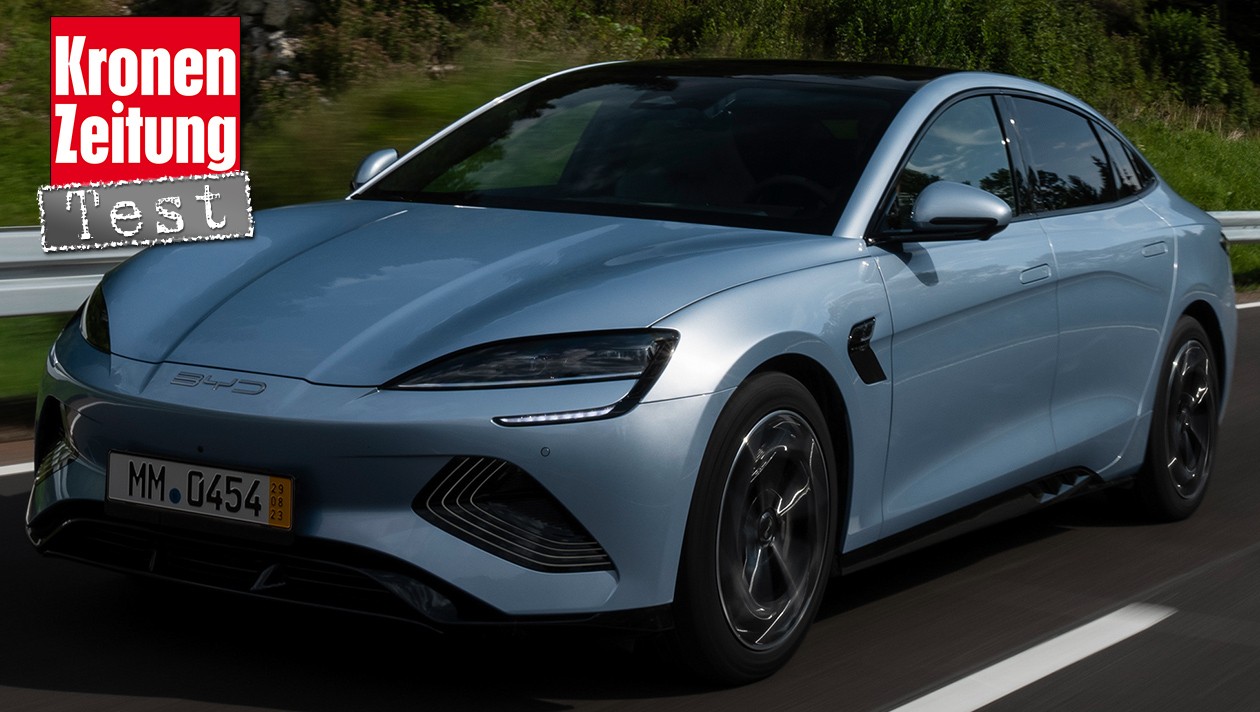BYD, Build Your Dreams, is currently launching one car after the other in Austria. In the fall, the Chinese will launch their take on cars like the Tesla Model 3 and BMW i4. “Krone” motor editor Stephan Schätzl was on the road in Bavaria with the 530 hp all-wheel drive version – his impressions here in the video!
In the spring I was able to check out the version intended for the Chinese market in advance (there is a video of it here). The chassis was still too soft and the company name BUILD YOUR DREAMS was written across the trunk lid. That was irritating. But the Chinese learn quickly from feedback: The European version only has a small BYD on the right rear, combined with the designation of the drive version. In the case of the “3.8S” test car. Which is also irritating, after all, one would expect a more powerful 3.8-liter V8 than an electric motor. But if Porsche can call its e-cars “Turbo” … it’s certainly potent, the 3.8S. With 390 kW/530 hp and 670 Nm, it pulls in powerfully and so effortlessly that no V8 would bring it together in real life. Of course, that’s how it is with electric cars. The two motors here are also so well insulated that you don’t even hear a whirring. Strong. The Robbe (= Seal) accelerates to 100 km/h in 3.8 seconds and is limited at 180 km/h. Alternatively, there is a rear-wheel drive with 230 kW/313 hp and 360 Nm, which also offers attractive driving performance; its advantage of being 130 kg lighter at 2055 kg enables a sprint value of 5.9 seconds. Cobalt-free cell-to-body battery The difference on the scales is not huge. This is because both have the same lithium-iron-phosphate battery as a component integrated into the frame (cell to body) in the floor. 82.5 kilowatt hours are enough with rear-wheel drive according to WLTP for 570 kilometers, the range of the all-wheel drive vehicle is 520 kilometers. They call this battery developed in-house a blade battery. The standard heat pump is good for the real range. The drag coefficient is also just 0.219. Despite the 800 volts, charging takes a relatively long time: BYD specifies a time of 26 minutes – but from 30 to 80 percent. The maximum charging power is 150 kW, with alternating current 11 kW. Plenty of space, fine ambience The integrated battery reduces the space requirement in the floor, which creates space. On the back seat, with an external height of 1.46 meters, there is excellent headroom under the standard panoramic glass roof, the long wheelbase of 2.92 meters allows a lot of knee room in the 4.80 meter long car. At 400 liters, the trunk is not record-breaking, but it is supplemented by a frunk that holds 53 liters in both drive versions. The interior is attractively designed, the workmanship is good, and the materials look high quality. Only the patterned decorative plastic on the center console does not want to fit in really harmoniously. Rotatable screen The 15.6-inch touchscreen changes from horizontal to vertical format at the push of a button. His reaction to fingertips should be more willing. The colors are friendly, the touch fields are usually large and easily accessible. With the German menu language, however, the designations of some points are irritating. It takes a while to get used to it and to be able to use the navitainment with all the settings without any problems. The speedometer display is almost annoying. On the right side the current tempo is displayed in numbers – easy to read. So far so good. In the same place on the left is displayed how much power you are currently using, in kilowatts. This is as unnecessary as it is irritating. It would not be surprising if this were changed via OTA update soon. More quirks – see video! The voice control reacts to “Hey BYD!” The suspension is still comfortable too. But: While the China version that was driven in the spring was still much too soft in the chassis, the Europa Seal fits our roads much better. It is good in curves, also steers in a useful way, but the steering hardly gives any feeling for the road. Even if it offers a little more resistance in Sport mode. The Seal is the first BYD that has double wishbones at the front and a five-link axle at the rear, so it’s built quite complex. The shock absorbers work adaptively. Unfortunately, they hold back a bit too much with their work, so that the Seal rocks intensively and for a long time on longer bumps. The prices for the rear-wheel drive called Design are due 48,380 euros, the all-wheel drive called Excellence is in the price list at 51,380 euros. This will include few extras, as the equipment is already very complete in both cases, right down to the adaptive cruise control with quasi-autopilot (but it doesn’t work very well). Market launch in December.FahrzitThe BYD Seal is both visually and financially attractive, it is comfortable and quiet, the drive is wonderfully powerful. Unfortunately, the chassis still leaves something to be desired, as does the steering. And you have to put up with the quirky service. They should think about something in Shenzhen. Let’s see if they implement the feedback again so quickly. For the time being, the Seal has not yet come close to Model 3 and i4.
source site-13
